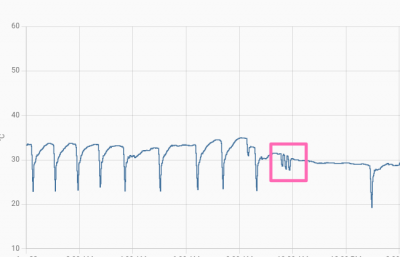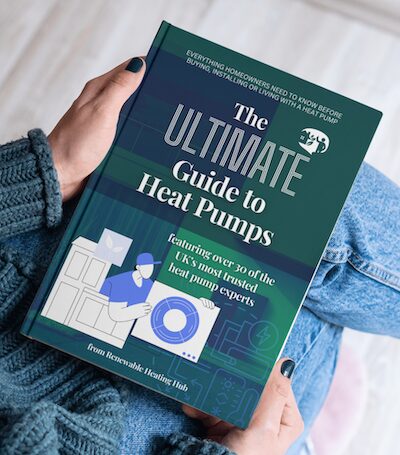GSHP running UFH but no feedback loop yet.
Hi, after a quick bit of advice on my house renovation;
GSHP is running and supplying UFH, it is not in an environmentally sealed room yet, it also has no temp sensors feeding back to it yet. I need to keep it running to dry and warm up house during renovation. How do I get some control of the GSHP output ( it is currently fluctuating with outside temp variations and costing about £25 a day to run. Do I rig up a temp sensor or focus on getting the room it is is situated in wind/waterproof?
thank you
Hi Alister, I'm not entirely sure what you're asking here? The output from the GSHP (i.e. the temperature of the heating fluid flowing around your UFH) is controlled by the heat curve that you've set on the pump (I'm assuming that all GSHP's work on the heat curve principal like NIBE's - so apologies if this isn't the case. I'm only familiar with my NIBE S1255). The temperature should, indeed, fluctuate with outside temp variation - the colder outside the higher the output temperature. So to bring down the cost of usage you need to lower the output temperature. You'll have to experiment to find out how low you can go, whilst still heating the house to your target temperature. If you're already there, then I suspect the only answer is more insulation. I note that you say "the room it is situated in" - this sounds like a bit of red herring to me. If you've got just one room - in which the HP is installed - which is not achieving target temperature then yes, sure, you need to get that room weatherproof. But that's not going to greatly impact the overall cost of running the system if the rest of the house is weatherproof and well insulated.
Whilst with NIBE pumps it is possible to control them from a temp sensor (or even from your room thermostats) I've been led to believe that this is not the "right" way to control them - and that the method outlined above, using the heat curve, is the correct/best way to control them
Graham.
@graham-s thanks Graham, yes my query is slightly odd as the whole system is not properly installed yet. We are not living in the house full time yet as it is still under renovation. I have dropped the offset by 6 degrees to keep the system running but not trying to get an uninsulated room up to comfortable inside temperature, the rest of the house is toasty! My pump room will be insulated soon so the problem of excessive running costs will go away completely as the property is very well insulated. I note your comments on thermostats, we have them for all seven UFH zones but they are not fitted yet. Every day is a school day with GSHPs so thanks for your help here.
@alistersmith I think it is important to get some basic monitoring in place [if you don't have it yet]. You don't need fancy stuff, but at least flow and return temp. If you can get flow rate, also good. I am still on my monitoring journey, but just having flow temp was enough for me to spot when things were not good. Such as this wobble when I reduced flow rate too much (to reduce pump noise). I had a similar wobble when I reduced target temp too much. (a PWM pump may fix that, will report back when I have one) [Note: The other dips are defrost cycles, it was -3 ish and quite foggy so I am ok with that]
Thanks, also got a S1255, been experimenting a bit with the offset ( we aren’t living there at present ) through MyUplink and managed to reduce consumption by 75% and still showing same internal temp. My flow return rates are early to mid 30 degrees and domestic hot water ( although not currently being used is similar to indoor climate supply/ return temps) . I will have running hot water from late feb so interesting to see how my consumption usage changes. House is now thermally secure and insulated, so happier to experiment with temp settings and the joiner hasn’t complained of the cold! I plan to run the UFH constantly at low temp as it is fitted in all downstairs rooms, any experiences of this or does anyone use their pump periodically?
Hi, I'm another recent convert to a Nibe S1255 - had to replace a very old GSHP. I do like it, much quieter and more efficient and great data feeds.....however, am now facing some strange issues with the heating coming on now the warm weather is starting to go!
My setup is a Nibe S1255, external hot water tank, underfloor heating with an external buffer tank. I am using the heat curve to manage my underfloor heating with individual temp controls in each room to open-close the relevant underfloor manifold not connected to the S1255. I have no central temp control.
Domestic hot water heating is going very well, we have a large tank and it's topping up the heat to 48-50deg after use and a small top-up around every 5-6 hours, switching off when it gets to 50 every time.
However, with the heating something strange is going on. As i am using the heat curve, I understand that the S1255 uses the Calculated Supply temperature to work out if heating is needed.
I currently have a calculated supply of around 29.2. When the actual Supply Temp dips below 29.2 the GSHP starts to warm the underfloor heating circuit. However, it never stops! Just keeps getting hotter!
The flow motor is working fine and I have good flow through my underfloor heating with 2-3 manifolds fully open - I can see the warm water passing through the underfloor pipes (I have a temp gauge on each manifold).
What is the trigger to stop the heating? My old GSHP would monitor the return temperature, and when that got to within 2-3deg of the supply temp it would stop warming the heating water.
With the Nibe there seems to be no such trigger. And mine just keeps warming the water until it goes into error mode! saying 'Max temp through heat pump exceeded'. It also goes way above the max temp of 47 which has been set in the heat curve.
I think i am missing a setting or perhaps there is a fault with my S1255?
The attached graph shows what's happening - I actually had the minimum external temp set very low to stop the heating coming on due to this problem. So to get the data I put the minimum external temp back up again at around 8.50pm. You can see the heating coming on, then the supply/return getting hotter and hotter. I would have thought it would stop around 30-35 degrees? Or are my flow/return not close enough (at end of graph the actual supply was 39.5 vs actual return of 37.8). It's pretty much around 1.5-2 deg difference between supply & demand from 9pm onwards.
Any ideas appreciated!
Pete
@petew Sorry for long delay but just finished adding my upstairs UFH and radiators. My set up is similar with five thermostatic zones which open/shut manifold, no central temp control other than the BT50 which is located near the heat pump. I am currently using the room thermostats to control demand but shortly due to increase these ( prob up to 21-22 degrees) and then control using the curve settings. This should allow me to find the comfortable temp level and then the thermostats will work as temp limiters - apparently more efficient rather than switch on switch off. Going back to your overheat, if the manifold is not demanding then your system isn’t working properly if it continues to climb in supply water temp. Worth checking your max flow temp 1.30.6? If you haven’t changed any of the installation settings or adjusted any other advanced settings (except curve) then I can’t think of a reasonable explanation other than some kind of fault.
@petew likewise apologies for not responding to your post (for some reason I wasn't notified?). Hopefully by now you've fixed your problem, which from what I can see in your graph clearly was a problem. I've never seen the temperature running away like that on my S1255. I do still get the occasional high pressure alarm when the pump appears to be still generating heat but there's no demand. If you have at least one UFH circuit uncontrolled (I. e. no stat, or the stat turned up to a higher temperature than you know will ever be achieved) then the problem goes away. Alternatively you need a buffer tank for the pump to dump it's excess heat/pressure into. But I think that's a different problem to the one you were seeing.
thanks! It did turn out to be a sort of fault - well, a bit of an installation issue....the return heating temp probe was not installed in the heat fluid return tank, so it thought the heating wasn't increasing so kept adding more heat! All sorted now. Thanks
- 26 Forums
- 2,323 Topics
- 52.1 K Posts
- 115 Online
- 5,979 Members
Join Us!
Podcast Picks
Latest Posts
-
RE: Electricity price predictions
@lucia Absolutely. And all this talk about being rea...
By Batpred , 1 hour ago
-

RE: Jokes and fun posts about heat pumps and renewables
And I thought I was the one with the taxi on speed dial...
By Majordennisbloodnok , 4 hours ago
-
RE: Solar panels on side of house to heat water
@paultheheating We are looking into PV panels at the...
By Batpred , 6 hours ago
-

@jamespa They are indeed mysterious devices!!! I have o...
By Toodles , 9 hours ago
-
RE: Heat Pump Training vs. Real-World Installation
Congratulations on passing the course. The observation...
By Max Abbey , 9 hours ago
-

RE: Hitachi Yutaki SCombi Heat Pump - Owners
@sim0n0 Here's a reply to help you out. As a owner ...
By trebor12345 , 11 hours ago
-
RE: Help me keep the faith with my air source heat pump installation
The engineer came yesterday and as the rooms were ok te...
By AdamK , 11 hours ago
-

RE: Replacing my 18 month old Hitachi Yutaki ASHP
@jamespa Can I check something that I done some weeks a...
By trebor12345 , 12 hours ago
-
RE: A2A vs A2W: Which Heat Pump Would You Pick?
The problem I see with A2A (and I'm interested if there...
By Temperature_Gradient , 13 hours ago
-

RE: British Gas vs Octopus Energy vs Heat Geek vs EDF vs Aira vs OVO vs EON.Next vs Boxt
@temperature_gradient I specifically explained to my po...
By Toodles , 13 hours ago
-

RE: Grant Aerona Short Cycling
@damonc I was refering to the 'standard' energy sticker...
By MikeFl , 17 hours ago
-

RE: Havenwise App Help & Forum Support – Get the Most from Your Heat Pump
@hcas where do I find Havenwise Support? On...
By Morgan , 17 hours ago
-
RE: Should Our Water Circulation Pump Be Configured to Run All The Time?
We recently (Aug 25) had a Grant Aeorana 3 installed un...
By GA3_USR , 22 hours ago
-
RE: Grant Aerona circulation/system pump staying on
My AERONA 3 circulation pump runs constantly whatever t...
By damonc , 1 day ago
-

RE: Configuring third party dongle for Ecodan local control
Thanks, @sheriff-fatman. Happy for you to search any po...
By Majordennisbloodnok , 1 day ago
-

Thanks, @cathoderay. I was aware of some changes to ...
By Majordennisbloodnok , 1 day ago
-
RE: Trying to understand my Nibe F1245
@greenlight Many thanks for the information, it's set m...
By Chris12 , 2 days ago
-
This is what I answered, I really have no hope: "......
By Batpred , 2 days ago
-







